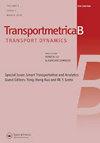Forecasting citywide short-term turning traffic flow at intersections using an attention-based spatiotemporal deep learning model
IF 3.4
2区 工程技术
Q2 TRANSPORTATION
引用次数: 6
Abstract
Prediction of short-term traffic flow has been examined recently, but little attention has been paid to the prediction of citywide turning traffic flow at intersections. Based on an in-depth analysis of turning traffic flow patterns, we propose a novel attention-based spatiotemporal deep learning model to predict citywide short-term turning traffic flow at road intersections with high accuracy. First, we examine the spatiotemporal patterns of turning traffic flow. Then, an end-to-end deep learning structure with four components is designed to model turning traffic flow. In our model, graph convolutional network is revised to learn spatial dependencies and sparseness, and gate recurrent unit network with an attention mechanism is developed to learn temporal dependencies and fluctuations. Experiments were conducted in Wuhan, China, where taxicab trajectory data were used to train and validate our model. The results suggest that our model outperforms current state-of-the-art models with higher accuracy on estimating turning traffic flow.基于注意力的时空深度学习模型预测全市交叉口短时转弯交通流量
本文章由计算机程序翻译,如有差异,请以英文原文为准。
求助全文
约1分钟内获得全文
求助全文
来源期刊

Transportmetrica B-Transport Dynamics
TRANSPORTATION SCIENCE & TECHNOLOGY-
CiteScore
5.00
自引率
21.40%
发文量
53
期刊介绍:
Transportmetrica B is an international journal that aims to bring together contributions of advanced research in understanding and practical experience in handling the dynamic aspects of transport systems and behavior, and hence the sub-title is set as “Transport Dynamics”.
Transport dynamics can be considered from various scales and scopes ranging from dynamics in traffic flow, travel behavior (e.g. learning process), logistics, transport policy, to traffic control. Thus, the journal welcomes research papers that address transport dynamics from a broad perspective, ranging from theoretical studies to empirical analysis of transport systems or behavior based on actual data.
The scope of Transportmetrica B includes, but is not limited to, the following: dynamic traffic assignment, dynamic transit assignment, dynamic activity-based modeling, applications of system dynamics in transport planning, logistics planning and optimization, traffic flow analysis, dynamic programming in transport modeling and optimization, traffic control, land-use and transport dynamics, day-to-day learning process (model and behavioral studies), time-series analysis of transport data and demand, traffic emission modeling, time-dependent transport policy analysis, transportation network reliability and vulnerability, simulation of traffic system and travel behavior, longitudinal analysis of traveler behavior, etc.
 求助内容:
求助内容: 应助结果提醒方式:
应助结果提醒方式:


